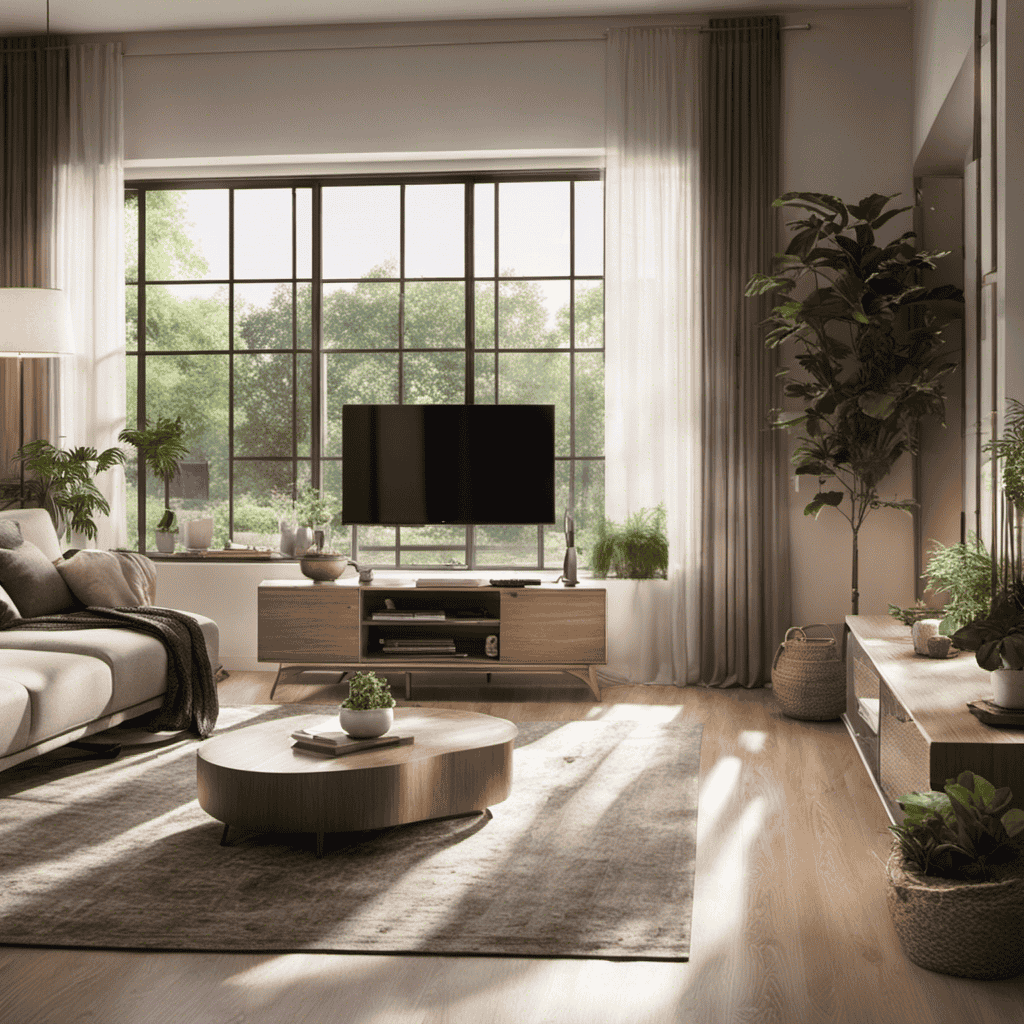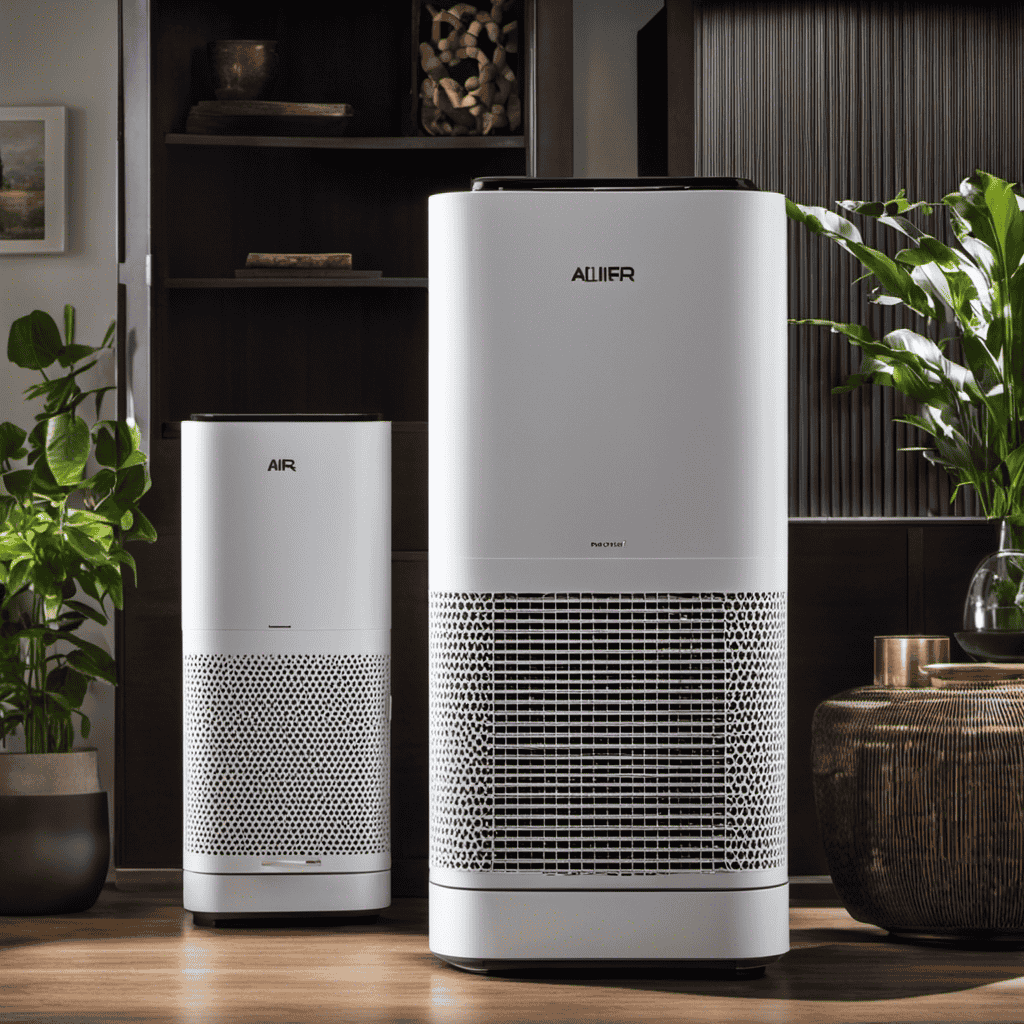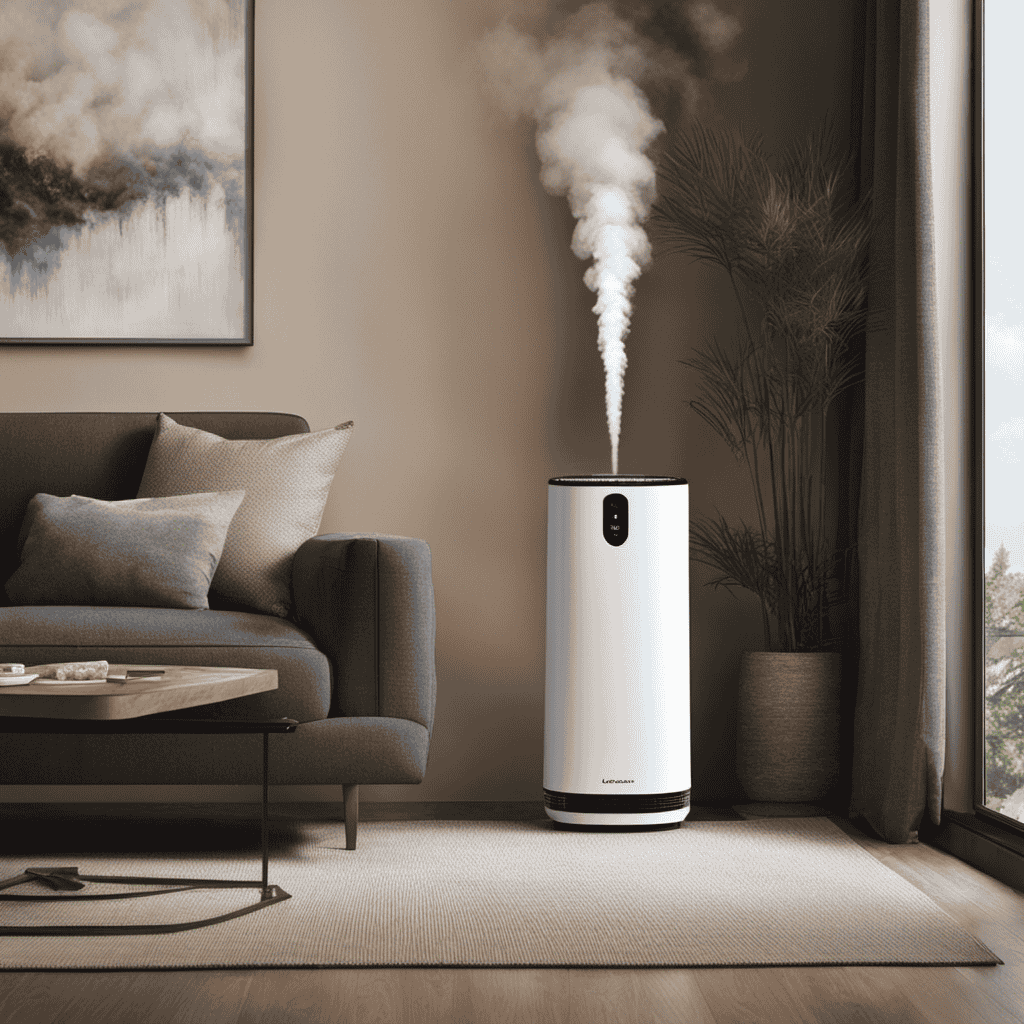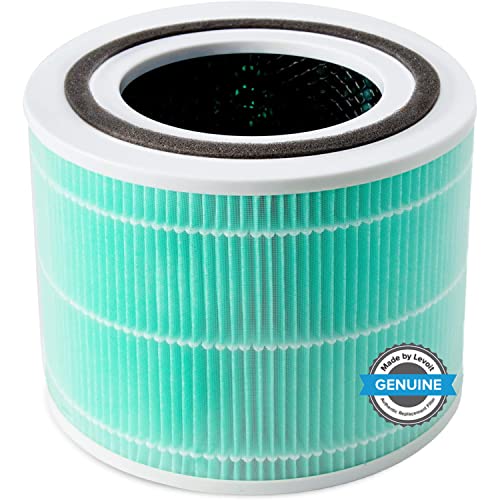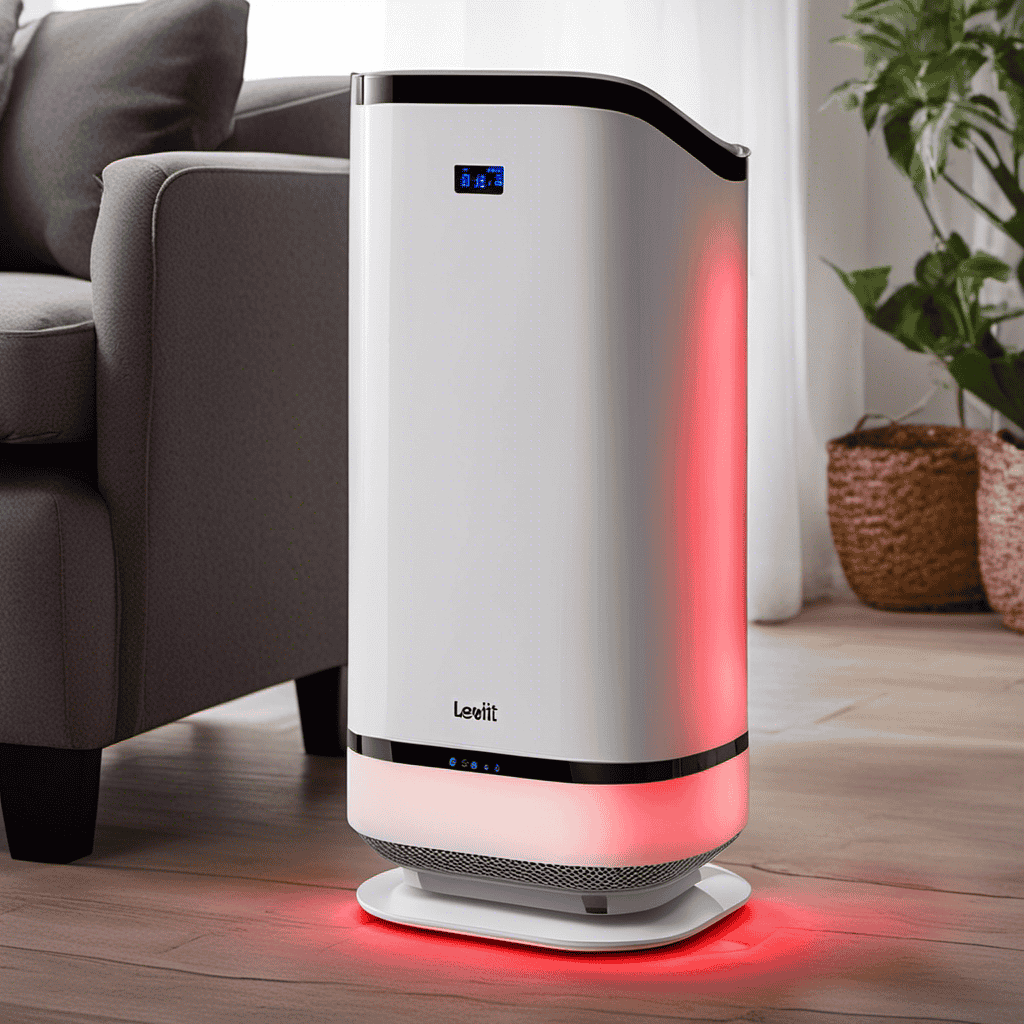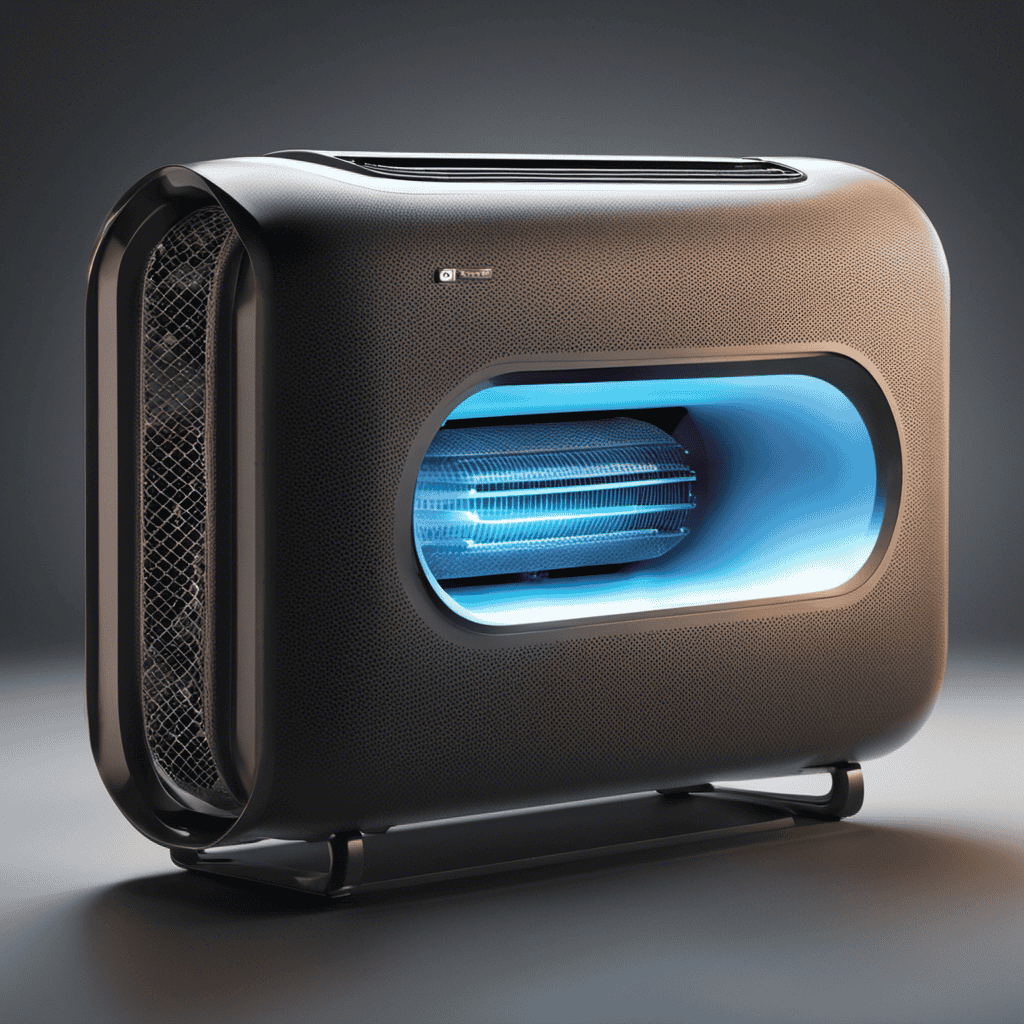As someone knowledgeable in air quality, I have found that running an air purifier is crucial for maintaining a healthy indoor environment. It is important to understand the frequency at which it should be operated to effectively remove pollutants and allergens from the air.
In this article, I will delve into the factors to consider when determining usage frequency and provide recommended running times for different environments. Whether you’re dealing with dusty rooms, allergies, pet dander, or pollution, I’ve got you covered with the ideal operating schedule.
Plus, I’ll share some maintenance tips to optimize your air purifier’s performance. Get ready to breathe easier!
Key Takeaways
- The frequency of running an air purifier depends on factors such as room ventilation, air quality monitoring, personal preferences, room size, and level of air pollution.
- It is recommended to run an air purifier continuously in polluted areas to maintain consistent air quality and prevent the buildup of harmful particles over time.
- The duration of allergy season varies depending on region and allergens, and it is important to monitor pollen count and consult with healthcare professionals for managing symptoms.
- Regular maintenance, including cleaning pre-filters every 2-3 months and replacing HEPA and activated carbon filters as recommended by the manufacturer, is crucial for optimal air purification and performance of the air purifier.
Benefits of Using an Air Purifier
Using an air purifier can greatly improve the air quality in your home, making it easier for you to breathe and reducing the presence of allergens and pollutants. Clean air has numerous benefits for our health and well-being. Breathing in clean air can help prevent respiratory issues such as asthma and allergies. It can also improve sleep quality and boost overall immune function.
Air purifiers are highly effective in removing airborne particles and pollutants from the air. They work by drawing in air and passing it through a series of filters that capture and trap contaminants. These filters can capture dust, pollen, pet dander, mold spores, and even volatile organic compounds (VOCs) that may be present in the air. The effectiveness of an air purifier depends on factors such as the type and quality of filters used, as well as the size and power of the device.
To ensure the best air purifier effectiveness, it is important to choose a unit that is suitable for the size of your room or home. Additionally, regularly maintaining and replacing the filters is crucial for optimal performance. Following the manufacturer’s instructions for filter replacement and cleaning will help maintain the air purifier’s effectiveness in providing clean and healthy air for your home.
Factors to Consider When Determining Usage Frequency
When determining how frequently to utilize an air purifier, there are several factors to take into account. It is important to consider the size of the room, the level of air pollution, and the individual’s specific needs.
Here are some key points to consider:
-
Room ventilation: The level of air circulation in the room plays a crucial role in determining how often to run an air purifier. If the room has poor ventilation or is located in a highly polluted area, it may be necessary to run the purifier more frequently to maintain clean air.
-
Air quality monitoring: Regularly monitoring the air quality in the room can provide valuable insights into the effectiveness of the air purifier. Using an air quality monitor allows you to track the levels of pollutants and adjust the usage frequency accordingly.
-
Personal preferences: Some individuals may have specific health concerns or sensitivities to certain pollutants. In such cases, it may be necessary to run the air purifier more frequently to ensure a healthy and comfortable environment.
Recommended Running Time for Different Environments
When it comes to running an air purifier, there are several factors to consider.
One key point to discuss is the difference between running an air purifier at home versus in an office setting.
Additionally, the duration of allergy seasons should also be taken into account, as this can impact the recommended running time of the air purifier.
Lastly, the size of the room in which the air purifier will be placed can have a significant impact on its effectiveness, and should be considered as well.
Home Vs Office
At home, it’s important to consider how often to run an air purifier. However, in the office, the same decision might not be necessary. The air quality in an office setting is typically controlled through centralized ventilation systems. These systems are designed to filter out pollutants and maintain a clean environment. However, there are some factors to consider when it comes to using an air purifier at work.
-
Energy consumption: Running an air purifier in an office setting can consume a significant amount of energy, especially if multiple units are used. This can lead to increased electricity bills and a larger carbon footprint.
-
Office layout: The layout of the office space can also affect the efficiency of an air purifier. If the workspace is open and well-ventilated, the need for an air purifier may be reduced. However, in enclosed spaces or areas with poor ventilation, an air purifier can help improve air quality.
-
Employee health: Consider the health and well-being of employees. If there are individuals with allergies or respiratory conditions, running an air purifier can provide them with cleaner air and improve their overall comfort and productivity.
Allergy Season Duration
During allergy season, you may experience symptoms such as sneezing, itchy eyes, and congestion. Seasonal allergies are caused by the body’s immune system reacting to allergens such as pollen in the air. Understanding the duration of allergy season can help you better prepare and manage your symptoms. The length of allergy season can vary depending on the region and the type of allergens present. For example, in some areas, tree pollen may be more prevalent in the spring, while grass and weed pollen may be more common in the summer and fall. Monitoring the pollen count can also give you an indication of when allergy season is at its peak. By staying informed and taking necessary precautions, you can minimize the impact of seasonal allergies on your daily life.
| Month | Common Allergens |
|---|---|
| March | Tree Pollen |
| April | Tree Pollen, Grass Pollen |
| May | Tree Pollen, Grass Pollen |
| June | Grass Pollen |
| July | Grass Pollen, Weed Pollen |
| August | Weed Pollen, Ragweed Pollen |
Note: These are general trends and can vary depending on geographical location and weather patterns. It is always recommended to consult with a healthcare professional for personalized advice.
Room Size Impact
When considering the effectiveness of an air purifier, the size of the room plays a crucial role. A larger room requires a more powerful air purifier to effectively remove pollutants and allergens from the air. This is because a larger room has a greater volume of air that needs to be filtered.
Additionally, the size of the room impacts the energy consumption of the air purifier. A larger room requires the air purifier to run for longer periods of time, resulting in increased energy usage. It is important to consider the size of the room when choosing an air purifier to ensure optimal performance and energy efficiency.
Transitioning into the next section, let’s explore how often to run an air purifier in a dusty room.
How Often to Run an Air Purifier in a Dusty Room
When it comes to running an air purifier in a dusty room, understanding the optimal run time, dust concentration levels, and health benefits achieved is essential.
Finding the right balance between running the purifier continuously and intermittently can help maintain clean air while conserving energy.
Monitoring the dust concentration levels in the room and adjusting the run time accordingly can ensure maximum effectiveness in removing airborne particles and improving indoor air quality.
Optimal Run Time
To achieve the best results, you should consider running your air purifier for at least 8 hours a day. This is the optimal run time for the purifier to effectively filter the air in your space. Running it for shorter periods may not provide the desired level of air purification.
When considering the optimal efficiency of your air purifier, it’s important to also consider its energy consumption. Running the purifier for longer periods may consume more energy. However, the benefits of cleaner air and improved indoor air quality outweigh the slight increase in energy consumption.
Here are three reasons why running your air purifier for at least 8 hours a day is beneficial:
- Reduces allergens and pollutants in the air, leading to easier breathing and improved respiratory health.
- Helps eliminate unpleasant odors, creating a fresh and clean environment.
- Prevents the buildup of dust and other particles, reducing the need for frequent cleaning and dusting.
By running your air purifier for the recommended amount of time, you can enhance the air quality in your space and enjoy a healthier living environment.
Now let’s explore the impact of dust concentration levels.
Dust Concentration Levels
If you’re concerned about dust concentration levels, it’s important to regularly clean and maintain your air purifier. Dust particles can accumulate in the filters of the purifier, reducing its efficiency in removing airborne contaminants. By following proper maintenance practices, you can ensure that your air purifier functions optimally and effectively removes dust from your indoor environment.
To help you understand the importance of dust prevention techniques and air quality management, I have created a table summarizing some key points:
| Dust Prevention Techniques | Air Quality Management |
|---|---|
| Regularly clean and replace filters | Monitor indoor air quality |
| Vacuum and dust surfaces frequently | Control humidity levels |
| Keep windows and doors closed | Maintain a clean living environment |
| Use dust-proof covers on furniture | Minimize the use of chemical cleaners |
Health Benefits Achieved
Maintaining a clean living environment can greatly improve your overall health and well-being. By investing in an air purifier, you can experience a range of health benefits and enjoy improved air quality in your home.
Consider the following emotional responses to convince you of the importance of clean air:
- Reduced risk of respiratory illnesses: Breathing in clean air can help prevent asthma attacks, allergies, and other respiratory conditions.
- Increased energy and productivity: Clean air can boost your energy levels and enhance your focus, leading to improved productivity and a better quality of life.
- Enhanced sleep quality: Breathing in purified air can help you sleep better, leading to improved overall health and well-being.
These health benefits highlight the importance of maintaining a clean living environment and the significant impact it can have on your daily life.
Transitioning into the subsequent section about the frequency of using an air purifier for allergy and asthma relief, let’s explore how often you should run your air purifier to maximize its effectiveness.
Frequency of Use for Allergy and Asthma Relief
Using an air purifier regularly can provide relief for allergy and asthma symptoms. For those who suffer from allergies or asthma, finding effective ways to manage symptoms is crucial. While allergy medication and breathing exercises can be helpful, incorporating an air purifier into your routine can make a significant difference.
Air purifiers work by removing allergens and irritants from the air, such as pollen, dust mites, and pet dander. By filtering out these particles, air purifiers create a cleaner and healthier environment, reducing the triggers for allergy and asthma symptoms.
To achieve optimal relief, it is recommended to run the air purifier continuously, especially in rooms where you spend the most time, such as your bedroom or living room. This ensures that the air you breathe is constantly being filtered, reducing the presence of allergens. Additionally, running the air purifier on higher fan speeds can help to improve air circulation and increase the efficiency of the filtration process.
Transitioning into the subsequent section, running an air purifier to combat pet dander and odors requires additional considerations.
Running an Air Purifier to Combat Pet Dander and Odors
When combating pet dander and odors, you’ll want to ensure that your air purifier has a HEPA filter. This type of filter is specifically designed to capture tiny particles like pet dander and remove unpleasant odors from the air. Pet hair management and reducing pet allergens are important aspects of maintaining a healthy indoor environment for both you and your furry friend.
Here are some reasons why running an air purifier can be beneficial for pet owners:
-
Relief from Allergies: An air purifier with a HEPA filter can help alleviate allergy symptoms by trapping pet dander and other allergens in the air. This provides relief to those who suffer from pet allergies.
-
Improved Air Quality: By capturing pet hair and reducing pet odors, an air purifier can help improve the overall air quality in your home. This makes it more pleasant and comfortable for everyone.
-
Peace of Mind: Knowing that your air purifier is actively working to remove pet dander and odors can provide peace of mind. It allows you to enjoy the company of your pets without worrying about the negative effects on your indoor air quality.
With these benefits in mind, it’s important to consider an ideal operating schedule for smoke and odor removal, which I will discuss in the next section.
Ideal Operating Schedule for Smoke and Odor Removal
To effectively remove smoke and odors, it’s essential to establish a suitable operating schedule for your air purifier. Smoke removal duration and odor elimination frequency are key factors to consider when determining how often to run your air purifier.
When it comes to smoke removal, the duration of operation depends on the severity of the smoke in your environment. If you’re dealing with heavy smoke from a fire or cigarette, it’s recommended to run the air purifier continuously for at least 24 hours. This will ensure that the air is thoroughly purified and the smoke particles are effectively removed.
For odor elimination, the frequency of running your air purifier will depend on the source and intensity of the odor. If you’re dealing with strong odors from cooking, pets, or chemicals, it’s advisable to run the purifier on a continuous or high setting until the odor dissipates. Once the odor is under control, you can switch to a lower setting or run the purifier periodically to maintain a fresh and odor-free environment.
How Often to Run an Air Purifier in a Polluted Area
In a polluted area, it’s crucial to establish a suitable schedule for running your air purifier. Running an air purifier continuously in such an environment can bring numerous benefits. Here’s why:
-
Continuous operation ensures that the air in your home remains consistently filtered, reducing the amount of pollutants you breathe in. This can have a significant positive impact on your health and well-being.
-
By running your air purifier continuously, you can effectively remove harmful particles such as dust, allergens, and pollutants from the air, providing cleaner and fresher air for you and your family to breathe.
-
Continuous operation also helps to maintain a consistent air quality level, preventing any potential buildup of pollutants over time and ensuring a healthier living environment.
While running your air purifier continuously offers these benefits, it’s important to consider the impact on energy consumption. Continuous operation may lead to increased energy usage, which can result in higher electricity bills. However, newer air purifiers are designed to be energy-efficient and often have low power consumption, mitigating this concern.
Maintenance Tips to Optimize Air Purifier Performance
Regularly cleaning and replacing the filters is essential for optimizing your air purifier’s performance. Maintaining a proper maintenance schedule is crucial to ensure that your air purifier continues to function effectively. The frequency of filter cleaning and replacement depends on various factors such as the air quality in your area, the type of filters used, and the manufacturer’s recommendations.
To start, you should consult the user manual that came with your air purifier. It will provide specific instructions on how often you should clean or replace the filters. As a general guideline, pre-filters usually need to be cleaned every 2-3 months, while HEPA filters and activated carbon filters should be replaced every 6-12 months, depending on usage.
When cleaning the filters, make sure to follow the recommended cleaning techniques. Pre-filters can often be vacuumed or washed with water and mild detergent. HEPA filters, on the other hand, are not washable and should be replaced when they become dirty or damaged. Activated carbon filters also need to be replaced as they lose their effectiveness over time.
Frequently Asked Questions
What Is the Recommended Lifespan of an Air Purifier?
The recommended lifespan of an air purifier depends on several factors, such as the quality of the unit and how often it is used. Regular maintenance is crucial to ensure its longevity.
Cleaning or replacing the filters, as recommended by the manufacturer, is essential. Additionally, keeping the purifier in a clean environment and avoiding excessive dirt or dust buildup will also help extend its lifespan.
Following these maintenance tips will help ensure optimal performance and a longer lifespan for your air purifier.
Can Running an Air Purifier Improve the Quality of Sleep?
Running an air purifier can potentially improve the quality of sleep by reducing airborne allergens and pollutants.
Air purifiers can help reduce snoring by removing allergens that can cause nasal congestion.
They can also benefit individuals with allergies and asthma by removing common triggers like pollen, dust mites, and pet dander.
However, it’s important to note that the effectiveness of an air purifier may vary depending on the specific model and the individual’s sensitivity to allergens.
Is It Safe to Run an Air Purifier Continuously?
Running an air purifier continuously is generally safe, but it’s important to be aware of potential risks. Continuous usage can improve air quality by removing pollutants, allergens, and odors.
However, some purifiers may produce ozone, which can be harmful in high concentrations. It’s crucial to choose a purifier that emits minimal ozone or none at all.
Additionally, regularly cleaning and maintaining the purifier is essential to ensure its effectiveness.
How Does the Size of the Room Affect the Running Time of an Air Purifier?
The size of the room can have an impact on the running time of an air purifier. A larger room may require the air purifier to run for a longer period of time to effectively clean the air. This is because there is more air volume in a larger room that needs to be circulated and filtered.
On the other hand, a smaller room may require less running time as there is less air to be purified. It is important to consider the room size when determining how long to run an air purifier.
Can an Air Purifier Eliminate All Types of Indoor Pollutants?
An air purifier can effectively eliminate many types of indoor pollutants, but it does have its limitations. According to a study, air purifiers can remove up to 99% of airborne particles, including dust, pollen, and pet dander.
However, they may not be as effective in removing gases, such as VOCs or odors. It’s important to understand the specific capabilities of your air purifier and choose the appropriate one for your needs.
What is the Recommended Frequency for Running an Air Purifier?
The running air purifier frequency depends on several factors, including the size of the room, the air quality, and any existing health conditions. In general, it is recommended to run an air purifier continuously on a low setting or at least for a few hours every day to achieve optimal air quality.
Conclusion
So there you have it, folks. After diving deep into the world of air purifiers and understanding the various factors that determine their usage frequency, it’s clear that running an air purifier is no walk in the park.
But fear not, for with the right knowledge and a touch of satire, you can conquer the world of clean air. Just remember to consider your environment, whether it’s a dusty room, a pet-filled household, or even a polluted area.
And don’t forget to give your air purifier some love with regular maintenance.
Now go forth, my friends, and breathe in the freshness of scientific cleanliness!
